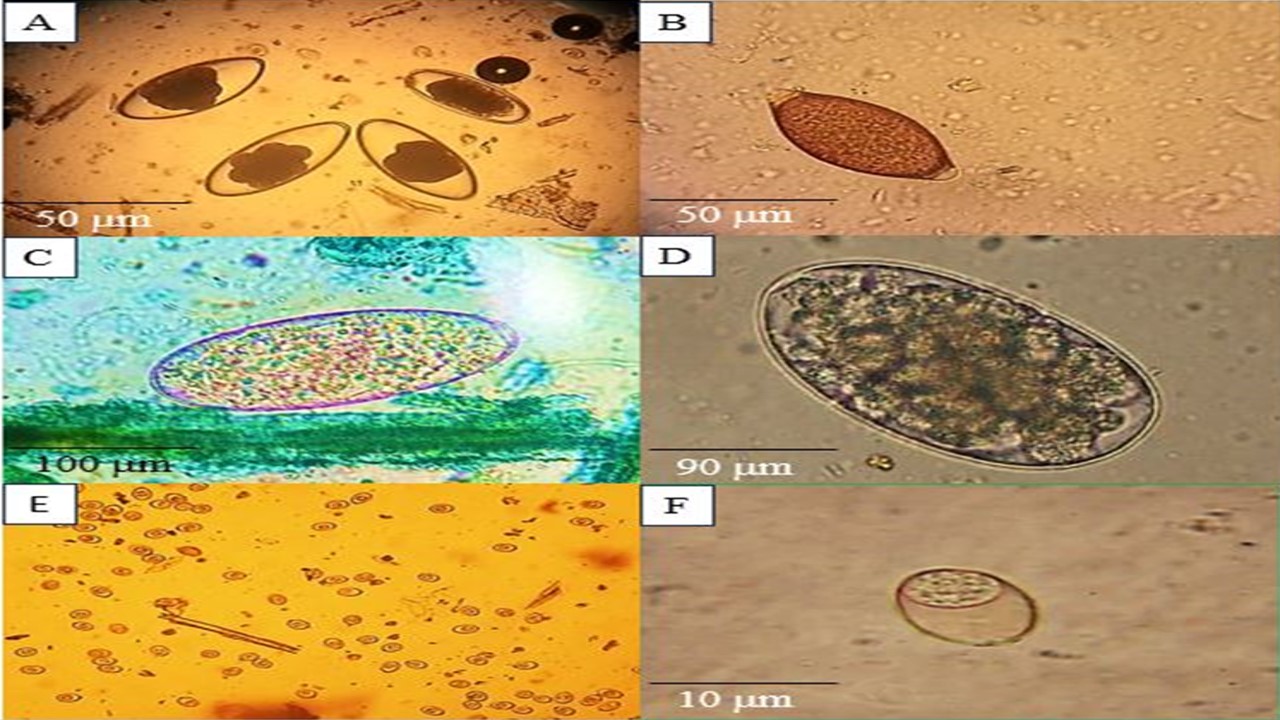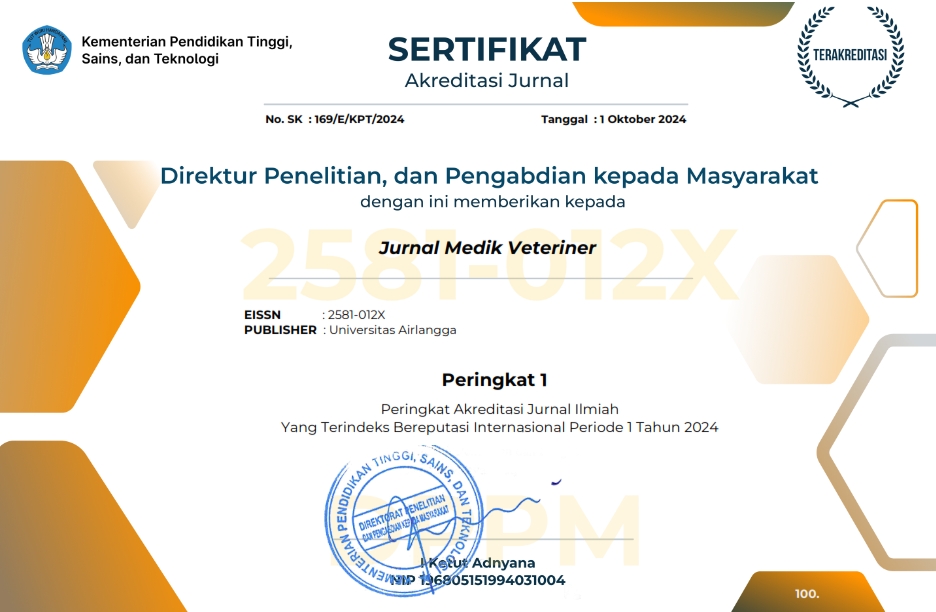Gastrointestinal Parasite Infections in Sheep from Torghondi, Islam Qala, and the Herat Slaughterhouse

Downloads
Gastrointestinal parasites (GIPs) pose significant health and productivity challenges to livestock, especially in regions with limited veterinary care and extensive farming practices. This study evaluated the prevalence of GIPs in sheep at the Torghondi and Islam Qala borders, as well as the Herat Slaughterhouse. A total of 450 faecal samples were examined microscopically, and 200 gastrointestinal tract samples (including stomach and intestinal contents) were analysed by dissection. The overall faecal infection rate was 77.3%, with prevalence rates of 76.7% at Torghondi, 90% at Islam Qala, and 65.3% at Herat Slaughterhouse. Eimeria spp. was the most prevalent parasite, detected in 73.7% of faecal samples. Nematodes (Nematodirus spp., Trichuris spp., Strongyle spp.) and trematodes (Amphistome spp.) were also identified. Gastrointestinal tract analysis revealed Trichuris spp. in 40.5% and Moniezia spp. in 37.5% of the samples. These findings highlight the roles of climate, livestock management, and environmental conditions on the distribution of GIPs. The high prevalence of parasites underlines the urgent need for effective control measures, including regular deworming, improved sanitation, and enhanced biosecurity practices. Future research should identify specific risk factors to inform targeted interventions and improve regional livestock health.
Asghari, A., Mahdavi, F., Shamsi, L., Motazedian, M. H., Asgari, Q., Shahabi, S., Mohammadi-Ghalehbin, B., & Sadrebazzaz, A. A. (2022). Prevalence and molecular characterization of Giardia duodenalis in small ruminants of Shiraz, southwestern Iran: A zoonotic concern. Comparative Immunology, Microbiology and Infectious Diseases, 86, 101819.
Asmare, K., Sheferaw, D., Aragaw, K., Abera, M., Sibhat, B., & Haile, A. (2016). Gastrointestinal nematode infection in small ruminants in Ethiopia: A systematic review and meta-analysis. Acta Tropica, 160, 68–77.
Bhat, A. S., Reshi, A. A., Mir, R. M., Husain, I., Sheikh, B. A., & Khan, H. M. (2014). Assessment of prevalence of parasitic infections in sheep reared in Kashmir valley, India. Journal of Animal Production Advances, 4(5), 416–421.
Castagna, F., Bava, R., Gagliardi, M., Russo, S., Poerio, G., Ruga, S., Lupia, C., Cringoli, G., Bosco, A., Rinaldi, L., & others. (2024). Prevalence of helminths in small ruminant farms and evaluation of control practices used to counter anthelmintic resistance in southern Italy. Pathogens, 13(6), 493.
Charlier, J., Rinaldi, L., Musella, V., Ploeger, H. W., Chartier, C., & Vineer, H. R. (2020). Initial assessment of the economic burden of major parasitic helminth infections to the ruminant livestock industry in Europe. Preventive Veterinary Medicine, 182, 105103.
Dey, A. R., Begum, N., Biswas, H., & Alam, M. Z. (2021). Prevalence and factors influencing gastrointestinal parasitic infections in sheep in Bangladesh. Annals of Parasitology, 67(2), 187–194.
El-Alfy, E. S., Abbas, I., Al-Kappany, Y., Al-Araby, M., Abu-Elwafa, S., & Dubey, J. P. (2020). Prevalence of Eimeria species in sheep (Ovis aries) from Dakahlia governorate, Egypt. Journal of Parasitic Diseases, 44(3), 559–573.
Hamzehali Tehrani, M., Shemshadi, B., Shayan, P., Shirali, S., & Panahi, N. (2023). Prevalence of abomasum nematode infection in sheep from North of Iran. Journal of the Hellenic Veterinary Medical Society, 74(4), 45.
Hassan, H. A., & Barzinji, A. K. (2018). Prevalence of ruminants' gastrointestinal parasites in Kirkuk Province, Iraq. Kirkuk University Journal-Scientific Studies, 13, 96–108.
Hatam-Nahavandi, K., Carmena, D., Rezaeian, M., Mirjalali, H., Rahimi, H. M., Badri, M., Vafae Eslahi, A., Shahrivar, F. F., Rodrigues Oliveira, S. M., & Pereira, M. d. L. (2023). Gastrointestinal parasites of domestic mammalian hosts in southeastern Iran. Veterinary Sciences, 10, 261.
Heart of Asia (HoA). (2024). The livestock industry in Afghanistan: Challenges and opportunities for economic growth. Heart of Asia. Retrieved from https://heartofasia.af/the-livestock-industry-in-afghanistan-challenges-and-opportunities-for-economic-growth/
Heckler, R. P., & Borges, F. A. (2016). Climate variations and the environmental population of gastrointestinal nematodes of ruminants. Nematoda, 3, 10–15.
Hendrix, C. M., & Robinson, E. (2012). Diagnostic parasitology for veterinary technicians (4th ed.). Elsevier.
Irshad, A., Ullah, A., Khan, M. F., Khan, W., Yasmin, S., Aksar, N., Sajid, U., Rahman, S., & Shah, S. S. H. (2023). Identification and prevalence of gastrointestinal parasites in goats and sheep of District Lower Dir, Pakistan. Journal of Xi’an Shiyou University, Natural Science Edition, 19(08), 251–256.
León, J. C. P., Delgado, N. U., & Florez, A. A. (2019). Prevalence of gastrointestinal parasites in cattle and sheep in three municipalities in the Colombian Northeastern Mountain. Veterinary World, 12(1), 48–54.
Maurizio, A., Stancampiano, L., Tessarin, C., Pertile, A., Pedrini, G., Asti, C., Terfa, W., di Regalbono, A. F., & Cassini, R. (2021). Survey on endoparasites of dairy goats in north-eastern Italy using a farm-tailored monitoring approach. Veterinary Sciences, 8(69), 33.
Otuu, C. A., Hassan, S. C., Urama, A. C., Ochaguba, J. E., Omalu, I. C., Eke, S. S., & Okafor, I. (2019). Prevalence of gastrointestinal parasites of sheep and goats slaughtered in Minna Modern Abattoir, Niger State, Nigeria. Journal of Animal Science and Veterinary Medicine, 4(2), 65–70.
Pinatih, A. K. R. T. D., Lastuti, N. D. R., Kusnoto, K., Mufasirin, M., Yunus, M., & Rahardjo, D. (2024). Prevalence of Gastrointestinal Parasites in Pigs in Bali. Jurnal Medik Veteriner, 7(2), 349–354.
Purnama, M. T. E., Dewi, W. K., Triana, N. M., & Ooi, H. K. (2021). Serum liver enzyme profile in Timor deer (Cervus timorensis) with fascioliasis in Indonesia. Tropical Biomedicine, 38(1), 57–61.
Roczen-Karczmarz, M., & Tomczuk, K. (2016). Oribatid mites as vectors of invasive diseases. Acarologia, 56(4), 613–623.
Skapetas, B., & Kalaitzidou, M. (2017). Current status and perspectives of the sheep sector in the world. Livestock Research for Rural Development, 2(1), 29.
Soulsby, E. J. L. (1984). Helminths, arthropods, and protozoa of domesticated animals (7th ed.). Baillière Tindall. pp: 50.
Squire, S. A., Robertson, I. D., Yang, R., Ayi, I., & Ryan, U. (2019). Prevalence and risk factors associated with gastrointestinal parasites in ruminant livestock in the Coastal Savannah zone of Ghana. Acta Tropica, 199, 105126.
Sukoco, H., Fahrodi, D. U., Salmin, S., Said, N. S., Marsudi, M., & Gading, B. M. W. T. (2023). Prevalence of Gastrointestinal Endoparasites of Swamp Buffaloes (Bubalus bubalis) in Polewali Mandar. Jurnal Medik Veteriner, 6(2), 173–179.
Sultan, K., Elmonir, W., & Hegazy, Y. (2016). Gastrointestinal parasites of sheep in Kafrelsheikh governorate, Egypt: Prevalence, control, and public health implications. Beni-Suef University Journal of Basic and Applied Sciences, 5, 79–84.
Taylor, M. A., Coop, R. L., & Wall, R. L. (2007). Veterinary parasitology (3rd ed.). Blackwell Publishing. pp: 17.
Taylor, M. A., Coop, R. L., & Wall, R. L. (2016). Veterinary parasitology (4th ed.). Wiley-Blackwell. pp: 33.
Tookhy, N. A., Isa, N. M. M., Rahaman, Y. A. (2024). Epidemiology of rumen fluke infection in selected buffalo farms in Perak, Malaysia: Prevalence, molecular species identification, and associated risk factors. Parasitology Research, 123(1), 99.
Widisuputri, N. K. A., Suwanti, L. T., & Plumesriastuti, H. (2020). A survey for zoonotic and other gastrointestinal parasites in pigs in Bali Province, Indonesia. Indonesian Journal of Tropical and Infectious Disease, 8(1), 55–66.
World Bank Group. (2014). Afghanistan - Agricultural sector review: Revitalizing agriculture for economic growth, job creation, and food security. Washington, D.C. Retrieved from http://documents.worldbank.org/curated/en/245541467973233146/Afghanistan-Agricultural-sector-review-revitalizing-agriculture-for-economic-growth-job-creation-and-food-security.
Copyright (c) 2025 Nazir Ahmad Tookhy, Dung Thi Bui, Esmatullah Haidari, Shoaib Ahmad Shakhes, Zabihullah Nasiry, Noor Ali Mohmand, Abdul Qader Pooyan, Mohammad Aman Haqmal

This work is licensed under a Creative Commons Attribution-NonCommercial-ShareAlike 4.0 International License.
Authors who publish in this journal agree to the following terms:
1. The journal allows the author to hold the copyright of the article without restrictions;
2. The journal allows the author(s) to retain publishing rights without restrictions;
3. The legal formal aspect of journal publication accessibility refers to Creative Commons Attribution-NonCommercial-ShareAlike 4.0 International License (CC BY-NC-SA).






11.jpg)




















